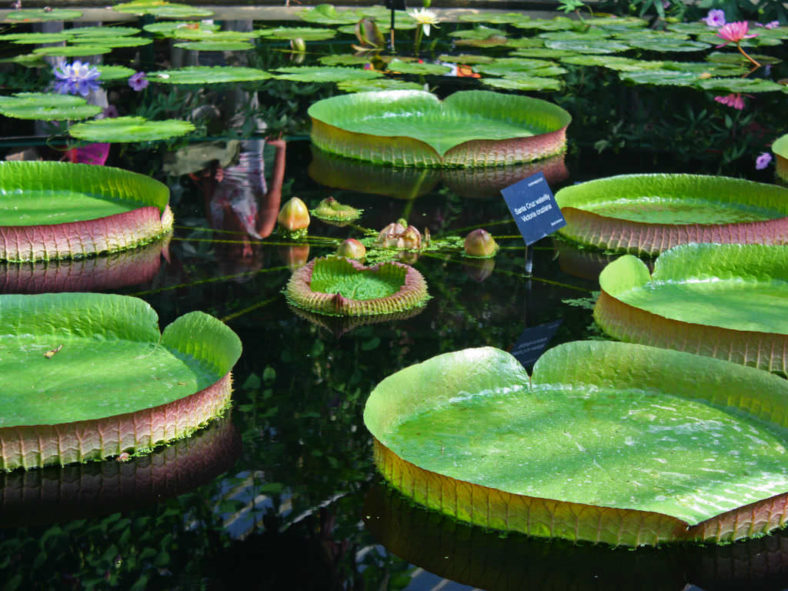Victoria amazonica, commonly known as Amazon Water Lily, Giant Amazon Water Lily, or Giant Water Lily, is well known for its huge circular leaves. The species is highly prized as an ornamental, despite having somewhat particular requirements for successful cultivation.
Native to tropical South America, Victoria amazonica was first discovered in Bolivia in 1801 and named Eurgale amazonica. It was subsequently moved to a new genus named in honor of Queen Victoria (originally Victoria regia). In South America, it grows in the backwaters of rivers in the Amazon Basin, the Guianas, and the Pantanal.
Description
Leaves: The enormous circular leaves, which grow to over 2.5 m across, have upturned rims and are anchored by long stalks arising from an underground stem buried in the mud of the river bottom. The leaves appear as spiny heads but expand rapidly up to half a square meter per day. The upper surface has a slightly quilted appearance and a waxy layer that repels water. The purplish-red undersurface has a network of ribs clad in abundant sharp spines, possibly a defense against herbivorous fishes and manatees.
Air trapped in the spaces between the ribs enables the leaves to float. They are so buoyant that they can easily support the weight of a small child, and a mature leaf can support 45 kg if the load is evenly distributed. Each plant produces some 40 to 50 leaves in a single season, which cover the water surface and exclude light, thus restricting the growth of most other plants.

Flowers: The spectacular flowers are relatively short-lived, lasting only 48 hours or so. The flower is white the first evening it opens, attracting beetles with a sweet pineapple-like scent and heat from a thermochemical reaction. At this stage, the flower is female and is open to receiving pollen picked up by the beetles on other plants. As they bumble around inside the flower, they transfer pollen to the stigmas, and fertilization takes place. Meanwhile, the flower shuts, trapping them until the following evening.
The following day, the plant changes from female to male: the anthers mature and produce pollen. When the flower reopens on the second evening, it has changed color to purplish-red and no longer emits an attractive scent or heat. The beetles, dusted with their pollen, fly off to find another white flower on a different plant (each plant only ever has one white flower at a time), where the process is repeated. The flower then closes up and sinks below the surface of the water, its mission accomplished.
Growing Conditions and General Care
The giant waterlily is a short-lived perennial in the wild, but at Royal Botanic Gardens, Kew, it is raised as an annual from seed planted each January.
In summer, the flowers are hand-pollinated and then placed in a bag. This enables easy collection of the resulting seed in the autumn. The seeds must be kept moist, preferably in water, all the time. To prevent premature germination or death, they are kept at a constant temperature of 15 °C. To begin germination, it is sometimes necessary to nick the seed with a scalpel, after which germination occurs in ten days. In January, the newly germinated seed is pricked out into a tiny pot kept in water. As the plant grows, potting on into larger containers is carried out until the plant occupies a one-ton pot. Loam is used as a substrate. The key factors for this choice are that it does not float, is rich in nutrients, and can enclose the fertilizer contained in the "feed bombs" given to the plant.
Carlos Magdalena, who cultivates this species at Kew, notes that temperature and light are crucial. The seedlings are raised at 32 °C, and the juvenile and adult plants are grown at 26 to 32 °C. In the winter, supplementary lighting must be provided for the seedlings. A 400-watt horticultural supplementary bulb is used to give bright light for 12 hours. The brighter and longer the exposure to light, the better and faster the plant grows. Eventually, in autumn, the lack of light finally causes the plant to die.
Pests and diseases are kept at bay with the provision of plenty of rich fertilizer, but aphids can be a problem.
If the plant becomes pot-bound, the crown tends to lift until it is raised out of the water. To counter this, the "chop and drop" technique can be used, whereby the crown is cut and planted in a new pot. Alternatively, the container can be placed deeper in the water. The general rule is the larger the pot, the larger and healthier the plant.
General maintenance includes weekly feeding throughout the season using 'feed bombs' and prompt removal of decaying leaves. The pot in which the plant is growing is kept submerged in water at all times.
Source: kew.org
Links
- Back to genus Victoria
- Plantpedia: Browse flowering plants by Scientific Name, Common Name, Genus, Family, USDA Hardiness Zone, or Origin

